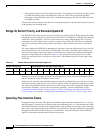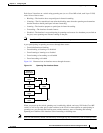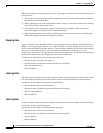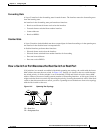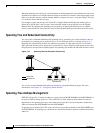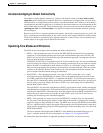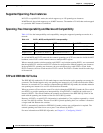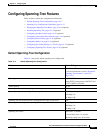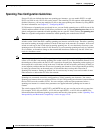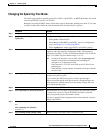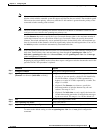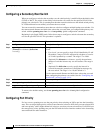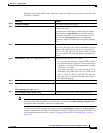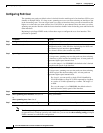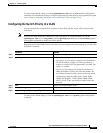
14-12
Cisco ME 3400 Ethernet Access Switch Software Configuration Guide
78-17058-01
Chapter 14 Configuring STP
Configuring Spanning-Tree Features
Spanning-Tree Configuration Guidelines
If more VLANs are defined than there are spanning-tree instances, you can enable PVST+ or rapid
PVST+ on NNIs in only 128 VLANs on the switch. The remaining VLANs operate with spanning tree
disabled. However, you can map multiple VLANs to the same spanning-tree instances by using MSTP.
For more information, see Chapter 15, “Configuring MSTP.”
If 128 instances of spanning tree are already in use, you can disable spanning tree on NNIs in one of the
VLANs and then enable it on the VLAN where you want it to run. Use the no spanning-tree vlan vlan-id
global configuration command to disable spanning tree on a specific VLAN, and use the spanning-tree
vlan vlan-id global configuration command to enable spanning tree on the desired VLAN.
Caution Switches that are not running spanning tree still forward BPDUs that they receive so that the other
switches on the VLAN that have a running spanning-tree instance can break loops. Therefore, spanning
tree must be running on enough switches to break all the loops in the network; for example, at least one
switch on each loop in the VLAN must be running spanning tree. It is not absolutely necessary to run
spanning tree on all switches in the VLAN. However, if you are running spanning tree only on a minimal
set of switches, an incautious change to the network that introduces another loop into the VLAN can
result in a broadcast storm.
Note If you have already used all available spanning-tree instances on your switch, adding another VLAN
creates a VLAN that is not running spanning tree on that switch. If you have the default allowed list on
the trunk ports of that switch, the new VLAN is carried on all trunk ports. Depending on the topology of
the network, this could create a loop in the new VLAN that will not be broken, particularly if there are
several adjacent switches that have all run out of spanning-tree instances. You can prevent this possibility
by setting up allowed lists on the trunk ports of switches that have used up their allocation of
spanning-tree instances. Setting up allowed lists is not necessary in many cases and can make it more
labor-intensive to add another VLAN to the network.
Spanning-tree commands control the configuration of VLAN spanning-tree instances. You create a
spanning-tree instance when you assign an NNI to a VLAN. The spanning-tree instance is removed when
the last NNI is moved to another VLAN. You can configure switch and port parameters before a
spanning-tree instance is created; these parameters are applied when the spanning-tree instance is
created.
The switch supports PVST+, rapid PVST+, and MSTP, but only one version can be active at any time.
(For example, all VLANs run PVST+, all VLANs run rapid PVST+, or all VLANs run MSTP.) For
information about the different spanning-tree modes and how they interoperate, see the “Spanning-Tree
Interoperability and Backward Compatibility” section on page 14-10.



